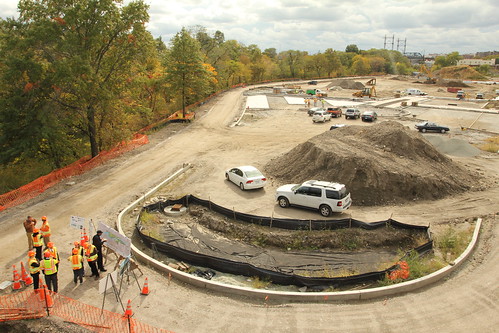
The re-building Star Light Park is finally making progress. (Photos: The Bronx Free Press)
For more than a decade the community has been denied access to Starlight Park's many ballfields, basketball courts and its waterfront while The Department of Transportation was allowed to use the much used public space as a staging area for construction equipment while repairing the Sheridan Expressway. In 2004, just after beginning the initial excavation, workers discovered remnants of a Con Edison plant which had formerly occupied the site. As expected, high levels of contaminants were found, including benzene and other toxins, which further delayed the project until the site could be cleaned up.
As part of the Bronx River Greenway, the DOT began renovating Star Light Park located along the Bronx River and the Sheridan Expressway between 172nd and 174th Streets. After years of delay, in 2010 the DOT announced it was finally breaking ground on a $17 Million project to build a new segment to extend the greenway and restore the park.
According to the Parks Department Starlight Park's amenities will include soccer/softball field, basketball court, playground for tots and pre-teens, play swings, spray shower, and a picnic area and construction of a multi-use path, plantings of various trees and plant beds. In addition it will provide access to the floating boat dock area and gangway, boat dock storage ramp and various outlook areas. A boathouse and comfort station are also in the plans. Starlight Park and the Bronx River Greenway will be connected with a pedestrian bridge over the Bronx River.
As part of the Bronx River Greenway, a proposed bridge over an Amtrak rail line is supposed to carry pedestrians and cyclists between two new waterfront parks and complete the scenic route. But the bridge project is now years behind schedule, due to a squabble between Amtrak and the state Department of Transportation, and has lost its funding. The U.S. Department of the Interior brokered a meeting last week between Amtrak and the DOT. - Geoffrey Croft

Bronx
A troubled bridge over Bronx water has greenway advocates singing a melancholy tune and the federal government scrambling to save the planned span, according to the New York Daily News.
Part of the Bronx River Greenway, the bridge over an Amtrak rail line will eventually carry pedestrians and cyclists between two new waterfront parks and complete the scenic route.
But the bridge project is now years behind schedule, due to a squabble between Amtrak and the state Department of Transportation, and has lost its funding.
The rail company and state agency have been at loggerheads since 2002, frustrating advocates who want an unbroken greenway from Westchester County to Hunts Point.
But the dam could break now that the Feds are involved. Last Friday, at the request of Rep. Jose Serrano (D-South Bronx), the U.S. Department of the Interior brokered a meeting between Amtrak and the DOT.
"I believe that the intervention of the Department of the Interior...will help solve the bridge impasse," Serrano said, calling the Bronx River Greenway the future "envy of the city."
Work on the greenway began in 2004 and is ongoing, with more than $150 million allocated to the massive project.
To complete the greenway, the DOT is renovating Starlight Park, a 14-acre tract it used as a staging ground years ago when repairing the Sheridan Expressway.
The agency broke ground at Starlight Park in 2010 and the space is slated to reopen next summer. But the greenway won't become continuous until the Amtrak line is bridged.
The span will allow walkers and bikers to reach Starlight Park and points north from the new Concrete Plant Park and Hunts Point, where street access to the Bronx River is limited.
"The greenway is going to be a wonderful addition to the landscape of the Bronx," said Linda Cox, executive director of the Bronx River Alliance. "But there's going to be a big gap until the bridge is built."
The DOT had secured funding for the Amtrak span and two bridges over the Bronx River by 2008, said Jerry Willis, a National Park Service officer lobbying for the greenway. But with Amtrak refusing to cooperate, the money was shifted to other projects.
The rail company worries about liability. The bridge project could turn up contaminated soil on Amtrak property or lead to a construction worker injury, said Amtrak spokesman Clifford Cole.
Amtrak was previously left holding the bag when a public project in Connecticut ran into trouble, said Willis.
"We are continuing to negotiate with Amtrak on a range of issues and look forward to moving ahead with the project," said state DOT spokesman Adam Levine.

The Bronx River House-Star Light Park. The proposed building be the administration headquarters for the Bronx River Alliance. It will provides office, program space including classroom and meeting spaces. The 7,000 sq. ft. structure includes a boathouse capable of storing approximately 30 canoes and 9 kayaks and will house a comfort station, according to the project's designer Kiss + Cathcart Architects. All the rain water will be captured from the roof and be used to flush toilets, wash canoes and irrigate the building's vertical green screen. There were some issues with the original contract and bidding of the $ 9 million dollar project. The new contract is expected to be re-bid shortly. (Image: Kiss + Cathcart Architects, Landscape Design - STARR WHITE HOUSE)
The stalled bridge to be built over the Amtrak rail line at 172nd St. is South/East of the bridge in the illustration above.
Read More:
Feds hope to bridge the gap: DOT & Amtrak meeting could solve impasse over Bronx Greenway planNew York Daily News - October 17th 2011 - By Daniel Beekman
The Bronx Link - October 15, 2010 - by Alexander Besant and David Patrick Alexander









